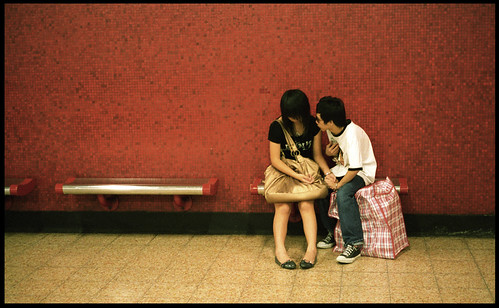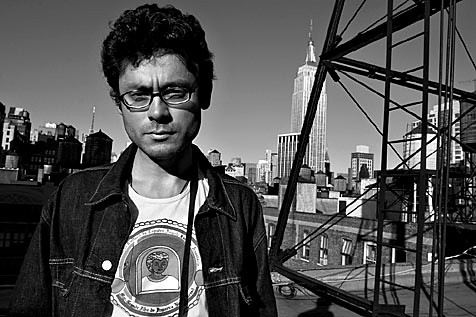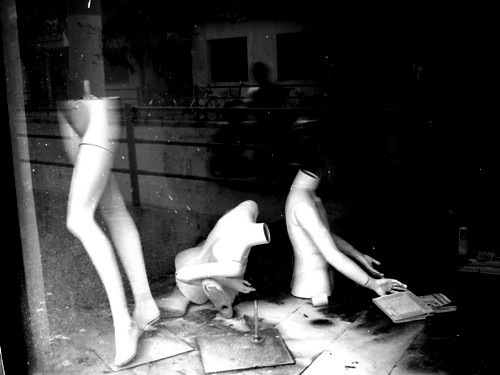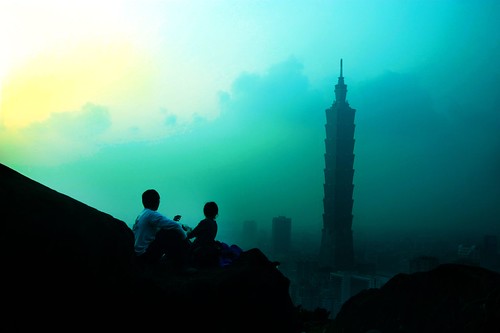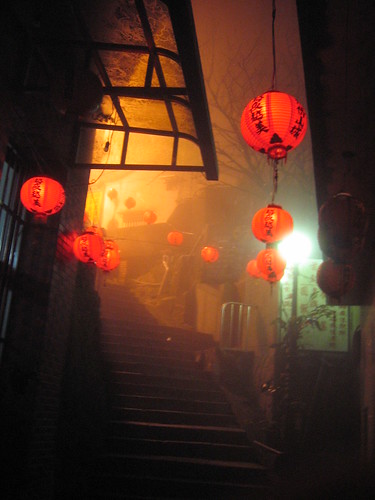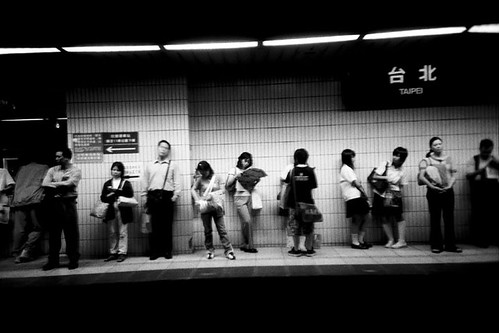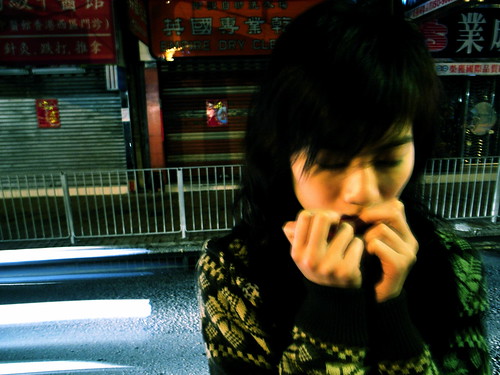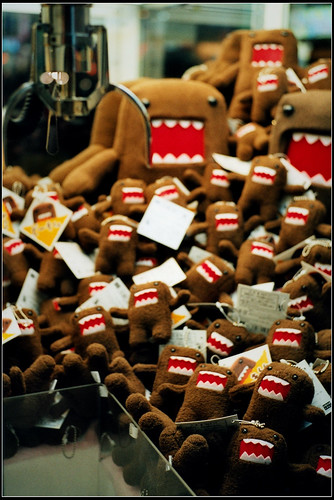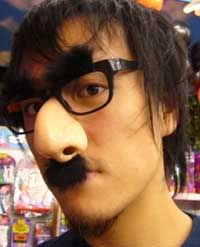Just like the guy making his way through this temporary walkway, I'm going through some stuff. The frequency of posts have been wavering as of late and I'm afraid the infrequency will likely continue. I wish it were easier to write about the photos that I love, but the truth is that at times writing is like pulling teeth. Years of leaving concise yet unspecific comments around flickr and elsewhere have left my writing sensibilities dull and decrepit.
I've tricked myself into thinking I could do a handful of things in my life all at once, but I sadly cannot. So while I look forward to continuing to share my thoughts on my favorite photography at clickclickclick, and while recognizing that continuing to write here regularly is one of the only ways I can hope to improve my writing, I confess that it's too much for me to attempt five, or even four, posts a week. Overexcited by this new project, and passionate about it to a fault, I have neglected to prioritize my life properly.
~~~~
Though his features are not visible to us,the man in the photo still appears to be sure-footed and certain of his destination. While darkness surrounds him on all four sides, his path is lit and he is about to turn the corner with a resolve that I contrastingly do not have. I know the pathway is a temporary one and that it serves to cover you between here and there but I still hesitate. So again I apologize. I will be posting much more infrequently from now on -- at least until I get myself from here to there.
Friday, March 7, 2008
Exit
Labels: fav, night photography, oceania, personal
Wednesday, March 5, 2008
Covered
Purposely obscuring part of a picture is one way artists sometimes force us to fill in the blanks. On two levels, that comes into play in Tetsuya Blues' photo above. The "2" is partially hidden behind the subject's head, while the head itself is turned away, obscuring the face. The number is easy to fill in, but the face isn't. We are left to wonder who this person is, unable to give this person an identity.
I like how my focus keeps shifting between the wall and the figure. I start with the circled numeral, then the enclosed head within. The sharpness of the subject draws me down through the contrasting textures of hair, fur, and creased fabric. And then I look to the Japanese text in soft focus behind.
With the gaze of the subject directed away from us, it's almost as if the focal point of the photo is that wall. I especially like how centered both foreground and background are. There's a tricky balance here that I think Tetsuya Blues has really nailed beautifully. I can't stop staring at this photo.
Monday, March 3, 2008
Excuses
Paul Swee is a Flickr user based in Hong Kong, and his photos capture bits and pieces of the surrounding metropolis. I enjoy browsing through his photostream to soak up the atmosphere of his city. Many of the shots are of everyday scenes, slices of life. In his profile, Paul states simply that "I shoot what I see."
He's being modest, of course. Here's a shot taken in Hong Kong's subway system. Looks like a young couple are having a falling out. The body language speaks volumes. The girl's toes pointed in, face turned down and away, limp arm, palm open, feeling hurt or dejected . The guy leaning in, trying to look the girl in the eye, holding tightly to the girl's hand, desperately perhaps. One hand motioning to his chest, maybe explaining his feelings or defending his actions. Paul offers a possibly overheard: "trust me, I didn't mess with your best friend."
I admire photographers that have captured intimate moments happening out in the open. It's mainly because it takes nerve to walk up to a person, frame your shot, and snap away. I suspect it might be a tad easier to get away with it if your subjects are too distracted by their own swirling emotions to notice the soft swish of a Leica shutter. Nonetheless, it takes a great deal of practice to obtain just a tiny bit of confidence. I better get out there.
Labels: asia, fav, slice of life
Friday, February 29, 2008
Bokeh
Bokeh describes the blurry quality of out of focus areas in a photograph. At large apertures, in the right settings, sometimes the light is transformed to resemble little Christmas ornaments. That's bokeh. Different lenses all have their own characteristic bokeh. In some of the flickr groups you can run across lens arguments debating the "good" or "bad" bokeh of one lens versus another. This post isn't about what makes good bokeh, though. I don't know anything about that.
I'm just here to show you this photo and tell you that kestra_400 is one of a band of photographers that does beautiful low light/available light photography. And he does it on film. My own experience shooting film is limited to my Holga and an old, crumbling Nikon that I have in no way wrapped my head around yet so there's not much insight I can offer into the way this photo was shot unfortunately. All I know is that it's not always easy to find places that bokeh beautifully.
I wonder if it has to do with the city. Many of the most beautifully executed photographs that feature predominant bokeh are set in the metropolises of Eastern Asia: Tokyo, Hong Kong, Taipei. It could just be my affinity towards tiny points of shiny light shooting out of the darkness. Drop one sharp subject in there, and I'm pretty much guaranteed to drop my jaw in return. I really like how in this shot the person in the foreground seems to be peering into the distance, admiring the lights just like we are.
It's great how there not only a variety in the colors, but also intensity, and nature of the blurred out lights. There are the blue solid lights that are clumping at the bottom, a similar clump to the left of orange lights, a row of red lights coming down diagonally, and then translucent-seeming bubbles of yellow and dark red floating up to the top. Staring at those lights, I can't help but guess what I'm looking at. I try to piece together a scene in my mind, but everything dissolves as soon I start to make any sense of it.
Labels: asia, available light, bokeh, dof, fav, night photography, urban
Wednesday, February 27, 2008
Getting By
Tiac is a really great photographer on Flickr and I always look forward to seeing updates on his page. The coolest thing about his work is that it's all done on a Sony compact digital camera. He has mentioned setting white balance to cloudy to get more warmth and upping saturation and contrast levels to the max. The results are really astounding. He captures ultra colorful images of the Taipei Mass Rapid Transit system and vicinity.
Here, Tiac has titled this photo "To Live", drawing our attention to the rubbish collector, picking up discarded cardboard on his tricycle just to get by and make a living. The crop is perfectly suited for the subject, straight and narrow. The arrows on that wall then further emphasize the straight grind that must be this man's life. There's nothing to do but keep going forward, on and on. I really like the angle and proportions of wall to street. That foreground line is a nice reinforcement of how confined that man is to his path.
I wonder if the decision was his own to make his living this way. What were the circumstances that led to this? There are quite alot of people in the city of Taipei who are in this line of work, so maybe it's as good a life as the next alternative, opening a soup stall or cleaning the escalators in the subway stations. It does seem like strenuous work, though. Hauling flattened cardboard boxes around day in and day out, rain or shine must be draining on the soul. Or maybe it's just what life is. It's work and he gets by. I bet there are people in fancy shoes and fancy suits that are mentally in the exact same place as this guy is.
Labels: asia, fav, slice of life, street photography, urban
Tuesday, February 26, 2008
Presence
I don't know anything about this man, other than the fact that he is a photographer. Like the wedding portrait I blogged on a few weeks back, I am amused to see a photographer so well photographed. I like how the subject's intensity is captured underneath the harsh sunlight. The lighting is far from ideal, and yet, the results look great. When I look at a portrait like this, I realize that my own work has got a long way to go. I can't even begin to guess how this shot looks so clean.
Maybe it's as simple as just telling a person to stand facing the sun, a "look at me", and then snap. But something tells me it's not that easy. Problems normal people have with a shot like this are nowhere to be found: washed out/overexposed forehead & nose, dark clothing blending in with dark background, blown out sky in background, lack of detail under harsh lighting, etc.
The execution of this shot is just spot on. The crop and composition are great. There's no superfluous space above the head, and the positioning of the subject 1/3 of the way into the frame is classic and works well. The crazy steel ladder and beams to the right strangely work nicely to balance out the rest of the photo. The skyline of the city in the back then grounds the photo and gives us an interesting background. This is a great example of how landscape orientation is just as suited for portraiture as portrait orientation is.
Monday, February 25, 2008
Perspective
Sometimes the difference between a regular snapshot and a striking photograph is the perspective. Instead of taking a shot from 5 feet off the ground, why not take it on the ground? Different angles force interesting perspectives in different situations. Here, more than half the scene is dominated by the tiles of this plaza, giving us an ant's-eye-view of the distant gate. With this super low angle, all the lines draw the eyes up and into that gate.
I like how all the bright illumination on the gate is mirrored in the ground as a watery reflection, giving the photo as a whole more body, and adding another element of interest to this already full frame. It doesn't become overwhelming, though, helped in part by the photo's predominantly monochromatic blue tone. And while the focus is soft, there's a feeling of sharpness as a result of the great contrast throughout. And yet somehow, the brightly lit white gate hasn't been overexposed.
If you can read Chinese, you'll be able to just make out the four characters that have since been taken down and replaced. "The Golden Mean and the Way of Righteousness" have given way to "Liberty Square" and what was once the CKS Memorial Hall is now the Taiwan Democracy Memorial Hall. I only lived in the country for three years, so I feel like my understanding of the politics behind the changes go way over my head. Nonetheless, the controversies revolving around words and monuments in Taiwan help to further throw images like this into greater perspective.
It's been a little over two years since I first saw and was inspired by this great shot. This, and a handful of other photos, all shot by a plastic camera called a Holga, convinced me to purchase my first "toy" camera, and simultaneously dive into the awesome world of medium format film. While the Holga is known as a lo-fi toy camera that produces selectively in-focus, heavily vignetted, square photographs, I love the Holga because of it's sometimes surprisingly crisp and high quality results. With a list price of $50 (cheaper on ebay) the camera is capable of producing stellar photographs. Like this one.
Labels: asia, fav, monochromatic, night photography
Thursday, February 21, 2008
Direction
I like the simplicity in this photo. It's an image of a person in front of a wall, arm outstretched to mirror the signage. The size of the white arrow is big enough to dominate the frame and loudly dictate: this way. The arm and index finger are nearly completely overshadowed and outweighed by this massive symbol, and yet, the arm stands out almost as much as the arrow. There's an interesting play between positive and negative space. Is the red wall the solid, with a cutout form of an arrow? Or is white the positive space atop a red background? How then does the arm factor in as an additional form? Is it a positive space surrounded by a colorless negative? Or vice versa?
There's also a juxtaposition of curves and angles: the organic and inorganic. Because the wall is backlit, the figure in the foreground is thrown into near total silhouette, not only creating a play between light and dark, but emphasizing the lines and curves of the human form versus the angular form of the arrow. What's so cool here is that we have two geometrically opposite shapes that convey to us the exact same message. A rectangle with a big triangle on the end registers as "arrow" which registers as "this way." A person with arm stretched out away from the body, three fingers curled in, registers as "person pointing" which registers as "this way" too.
I think the vignetting from the Lomo LC-A camera helps to further emphasize the brightness of that arrow. The use of the arrow as the primary light source is beautifully done. I especially like how the figure isn't totally dark, the light subtly washing across the t-shirt and wrapping around the arm and fingers. What a cool effect.
Labels: asia, available light, backlit, fav, graphic
Wednesday, February 20, 2008
Disembodied
One really exciting element of photography is discovery. I'm not sure if anyone ever thinks "today, I'm going to shoot mannequins." Plastic torsos can be categorized underneath found objects. It's not like nature or landscape, where you start with an idea of what is beautiful or interesting, and then go out and find it. Broken down body parts like the ones above are definitely something you find on accident, perhaps on the way to the corner store. This is why cameras must never be left behind on even the shortest of errands. Out of toothpaste? Better get your camera. Who knows what's out there waiting to be discovered.
I would have loved to be confronted with a window display like the one above. I feel that the gestures and positioning of those arms and legs really speak to me. In the front, oblivious to its own state of disrepair, a pair of slender legs poses daintily. Below it, a figure that has not only lost its head, but has fallen over heels lies in an awkward position. Behind, a final poised half-figure with back turned to us pretends to restore order to clumps of discarded rubbish. Whoever threw these leftover mannequins in this heap must have had a real eye for composition.
I also like the starkness of the bright white, clearly defined, figures surrounded by darkness. This is all that remains of some forgotten boutique or department store: an eerie reverie. It reminds me of Shelley's Ozymandias that thoroughly unimpressed me in middle school, and later proved to be poignantly appropriate when used in Alan Moore's Watchmen (hopefully not overly melodramatic when inserted here):
I met a traveller from an antique land,
Who said--"Two vast and trunkless legs of stone
Stand in the desart....Near them, on the sand,
Half sunk a shattered visage lies, whose frown,
And wrinkled lip, and sneer of cold command,
Tell that its sculptor well those passions read
Which yet survive, stamped on these lifeless things,
The hand that mocked them, and the heart that fed;
And on the pedestal, these words appear:
My name is Ozymandias, King of Kings,
Look on my Works, ye Mighty, and despair!
Nothing beside remains. Round the decay
Of that colossal Wreck, boundless and bare
The lone and level sands stretch far away."
Labels: asia, b/w, fav, found objects, still life, urban
Tuesday, February 19, 2008
Naptime
Had myself a four day weekend. To celebrate all the nothing I accomplished, I think this polaroid of Baobao the cat is in order. Flickr user Babykailan has got two very photogenic cats and a couple different cameras at his disposal. The shot above is one of only a couple shots from his Polaroid SX-70, but I think it does the best job telling the one-panel story of "the sleepiest cat in Flickr".
One great quality of photography is that not only can it record an event, a person, or a place: serving as a backup for our faulty memory, but it can augment or transform memory: telling multiple stories where there may have been none. Maybe Baobao has a daily habit of eating lunch and lying down for a nap wherever there is an unoccupied chair. Looking at the photo, however, I see Baobao padding around an apartment on a Saturday afternoon and discovering that his favorite green chair has been pushed into a patch of sunlight coming through the living room window. Settling in, he thinks to himself, Beibei was extra nice to me today, maybe tomorrow I'll let him win when we play-fight in the morning. As he drifts off to sleep, he chuckles silently as a man wielding a funky folding camera comically tries to find the right angle by which to capture his cat on polaroid.
Drawn in by an appropriately fuzzy focus and soft, hazy exposure, I can't help but feel content along with Babykailan's beautiful cat. It brings a smile to my face. I hope to see more polaroid shots from Babykailan's flickr stream. Unfortunately, there might be a problem. While it seems like there's been an increasing numbers of polaroid shooters on flickr, Polaroid announced just a couple weeks ago that it is ditching the instant film market and would be closing their film factories by the end of the year. It's really too bad. I guess this pricey niche camera/film will be remaining niche and be turning much pricier in the years to come.
Thursday, February 14, 2008
Wed
I'm not sure who was in charge of the framing of this great portrait, but I love the decision to chop bride and groom in half, leaving that patch of red background right in the center. Burpsean on the left and Ivy on the right are both on flickr and I'd like to think that they were the creative minds behind this great wedding portrait. One commenter left a message saying this shot resembles a typical Korean horror movie flick poster. I totally agree in that there's an intensity to the shot: in the colors, the expressions, and the preciseness of it.
The lighting on both bride and groom is perfect. The lighting on that background is nicely down as well. I wonder if it was done with studio strobes or something simpler, like a diffused flash straight ahead, reflector beneath, and something lighting the red background. The even lighting works really nicely here to highlight a clean, straightforward shot with an unconventional composition.
There's not much else to say here. Other than Happy Valentine's Day to everyone celebrating it. Also, I hope I eventually get a chance to be in such an awesome wedding portrait. Or shoot one.
Labels: asia, fashion, fav, portrait, wedding photography
Wednesday, February 13, 2008
Flying
I couldn't help myself. Here's another Lomo LC-A shot, this time featuring Agfa film. Just as different digital cameras seem to process colors in subtly different ways, producing varying degrees of true-to-life-ness, film results vary from company to company. Kodak is known for warm tones, verging on being an orange-ish color cast. My parents were partial to Kodak film, so I suppose I've grown up accustomed to seeing photographs with this kind of look. When I started shooting with my first digital camera, I instinctively color corrected my photos to have that warmth. Kodak's biggest competitor, Fuji, is known for slightly cooler color reproduction, with greater saturation. Above, we have an example of Agfa film, which boasts extreme color saturation.
Naturally, this is the perfect film for the Lomo LC-A, which also boasts super saturation. The result speaks for itself. All I can add is that simple cameras are good at reminding us that bright sunshine + 100iso film = winning photos featuring vivid colors & high contrast. If you've read some of the other posts, you may know that I love night time shots with dramatic lighting. Those kinds of conditions require specific techniques/equipment: longer exposure times, tripods or surrogate tripods like chairs or trashcans, and the ability to hold your own if cornered in that dark alley during a night shoot.
It's good to realize that there are great opportunities in broad daylight. The type of energy and emotion that Lee Wei-I has captured above is just as intense as many of my favorite after dark photographs. Looking at it now, it reminds me that I have some neglected cameras that are looking for some action. In fact, after seeing some of a great shots that Lee Wei-I and other have been able to get on Agfa film, I ran out and bought a few rolls. This morning I was scratching my head, wondering where those had gone, when I realized the film was still wound in my Nikomat from over one year prior. I got to go get that developed.
Tuesday, February 12, 2008
Crossing
Lighting is everything. Just like how a beautiful model can be ruined by poor lighting, a bustling intersection can be reduced to a static mess of indistinct blobs when shot without consideration of the light source. With the right eye, however, and careful attention paid to natural available light, a simple scene (above) of people crossing the street can be transformed into something magical.
What I love about the lighting here is that the low angle of the sun casts the shadows of the pedestrians down onto the striped crosswalk, adding strips of dark, textureless shadow to the alternating bands of bright reflective white and gritty black asphalt. It almost looks like the white stripes are rays of light stretching down from the upper left. And whereas I might have blindly just tried to shoot silhouettes of back-lit pedestrians, abre/tus/ojos has chosen at angle about 45 degrees from perpendicular to the sun's rays, that has captured the pedestrians with a thin slivers of side-lit highlight. It's just perfect.
Tilting the camera slightly down, he's cropped out any potentially distracting sky or buildings. What is left is a full frame of crosswalk. With the amazing highlights, each person is discreet and clearly visible. I like the sharpness of the forms, making it seem as if we have paused a bustling scene. It feels as if the serenity of the moment might be broken with one false move. And I wonder, are these people on their way to work, energized and invigorated by the rays of a new day's sun? Or are their steps heavy after a long day's work, aching, yet rushing to get home.
Monday, February 11, 2008
Shinjuku
Here's a glorious example of cross processed slide film out of a Lomo LC-A. This is a great night time shot filled with plenty of interesting detail. For me, this photograph has become iconic of one of the busiest districts of one of Asia's busiest cities: Shinjuku, Tokyo. Shooting from a pedestrian overpass, Clarice was able to capture the towering neon billboards and store marquees illuminating the busy street below.
The wonderful contrast and saturation really makes this image shine. It's likely due to a combination of the 100iso film and the cross processing. The choice of film, Kodak Ektachrome, along with the color temp of those street lamps probably contributed the green cast. The sharpness through most of the scene and the vignetting at the edges are thanks to the awesome Lomo LC-A.
I'm somehow drawn to the motif of striped crosswalks, featured at the bottom of this frame, and pedestrians at night. I feel that it's a key element in the concept of urbanity. While the night encroaches from all sides, the metropolis holds the stifling darkness at bay. The deep patches of black night all around serve to set the lights in brilliant relief. Looking at this photo from a distance, or as a thumbnail, the jumble of lights seem to explode out of that vanishing point, moving not just out towards the edges of the photo to conquer that night, but up and off the page/screen to enforce its super-reality.
Labels: asia, available light, fav, night photography, urban, xpro
Friday, February 8, 2008
Nostalgia
Can you be nostalgic about a place you left less than a year ago? Or feel intimately familiar with a location in which you've never set foot? It's weird, but it feels like I've been up on this popular vantage point above the Taipei basin countless times when I haven't. I get the feeling that I somehow recognize those two people, gazing out towards the Taipei101 building, admiring the thin mist as it envelops the city in a strangely photogenic mugginess.
False memories aside, I like how =Rebirth has created this faux cross-processed effect with the high contrast and bluish color cast. Cross processing is a technique done with film, where you process slide (positive) film in chemicals meant for negative film, or vice versa. The results vary depending on the film, and can range from looking completely monochrome green or red, to having a bluish super saturated look. One thing that helps exacerbate these wonky effects is "pushing" the film, meaning you expose an 100iso roll of film as if it were 400iso, then telling your lab tech to develop the film as if it were 400iso film (which would be 2 stops).
Alternatively, you could shoot a scene on your digital camera and go to work in your post processing software of choice. Definitely not the easiest route to take. =Rebirth has done a phenomenal job with this shot. Aside from his xpro treatment, I love the composition, and all the details he's somehow preserved in both the figures, buildings, and clouds. Plus, it must be said that finding such a beautifully gradated sky is harder than many might think. Thankfully, =Rebirth was on hand to catch it on this day. I wonder where I was. Probably shut indoors, playing guitar hero when I should have been out shooting.
Thursday, February 7, 2008
Green
This photo is one of my all time favorite shots on flickr. I love the monochrome treatment and artful composition. The lush greenery fills the foreground and surround the temple which presides over the entire scene, overlooking the city of Kyoto. Then in the extreme distance, there are misty mountains, cradling the city from the other side. Add the billowing clouds above, and the scene is complete. I like how the slight halo effect around the pagoda and above the trees, probably a result of contrast/sharpening adjustments in post, seems to mirror the way the clouds are lit in the sky.
If this were a composite, I'd nod and think, wow, well done. However, in the comments on flickr, 3amfromkyoto reveals that aside from the standard post-processing tweaks to color and contrast, there was no editing (removing/adding objects). I believe it. The framing of this shot feels to me like its the result of careful deliberation and patience. Not sure how he did it, but each element has such a crispness to it. Must be a mix of great lighting, attention to exposure, and post-production finesse.
3amfromkyoto is truly a masterful artist who features amazing work on his flickr account. He deals in textures and ambiances, choosing to capture and create scenes both real and surreal. I think one problem I face in my photographic pursuits is that I don't have my own style or voice. There have been shorts spurts where I've leaned heavily in one stylistic direction or another, but an overarching theme or look has been missing. And so it's with envy and admiration that I look up to photographers like 3amfromkyoto, who have such breadth, yet retain an instantly recognizable style.
Labels: asia, fav, landscape, monochromatic
Wednesday, February 6, 2008
Red
This photo features Jiufen, a popular travel destination for tourists and photographers near the northern tip of Taiwan. For all those who had the poor luck to visit during rainy weather, I'm envious of you for having had the good luck to find yourselves in such a misty maze of alleys and stairways. I never had such good luck. The one time I visited, the weather was clear to partly sunny, chance of shooting mist 0%.
Of course, capturing mist is not all about luck. It's about lighting and exposure. In this photograph, Socwind must have had a hard time getting the shot to come out nicely due to the wide range of lighting in this one frame. However, the orange light off frame at the top of the stairs, the bluish lamp in the upper right, and the red lanterns somehow worked. They melded together to create this web of silhouettes, highlights, shadows, and impressions. The part of the shot that gives me the shivers is that tree creeping in the background. It's awesome how that awning in the foreground just happens to have similarly creepy water stains.
The most striking feature of Jiufen, though, are the red lanterns that hang through all of the alleys and stairways of the village. They light up at night and feature the words (roughly translated): the more night, the more beauty. This photo has captured them beautifully. With the wide angle, we get a great perspective and sense of scale as the lanterns shrink into the distance and disappear in the warm glow around the corner. As warm and dreamy as it all looks, though, I can't seem to shake a feeling of trepidation. It's like I've been here before, lost in a maze of winding streets, disoriented by the lights and unable to find my way. I like how photographs expand past their frames and offer alternate worlds and hidden stories. It's part of what excites me about photography.
So keep shooting and Happy Chinese New Year everybody!
(I wonder if I maybe should start another new blog, psychoanalyzing my blogposts on clickclickclick)
Labels: asia, fav, night photography
Tuesday, February 5, 2008
Blue
Motionid is one out of a handful of photographers over in Japan walking around with amazing lenses strapped around their necks, documenting what they see on the city streets. I've been hooked on this guy's work as he has a knack for capturing subtle emotions in tack sharpness with scarce available light. Each candid portrait is loaded with feeling. The shallow dof afforded by the fast lens isolates these people, magnifying their expressions.
When I see an image like this, I feel like there's a whole story here. One commenter on flickr described the photo as having a cinematic tone and I agree. It's not just the wide crop and the dramatic lighting, but the sense that we are seeing a single frame from a movie. I wonder what it is that's weighing down his shoulders, causing that subtle lean. I wonder what music this man might have playing in his earphones that might cause him to pause and furrow his brow that way. He's dry, but that raincoat tells me maybe he expects stormy weather.
Looking through motionid's stream and seeing photos like this one has opened my eyes to the beauty of cooler color casts at night. I've always tweaked my photos in post to get a warmer, kodak-like, temp. I realize that I've neglected a world of blues and violets that I now want to go out and capture.
Labels: asia, available light, dof, fav, night photography, portrait, street photography
Monday, February 4, 2008
Glow
There are alot of photography rules. One is don't shoot into the sun. It saps the contrast out of a shot and washes all the colors out. Another rule is don't try to get backlit shots unless you want a silhouetted foreground or burnt out background. Well here's a photograph that does both--with glorious results. Sunsets, along with puppies and flowers is one of the most derided photo subjects on flickr. In defense of sunsets, though, it's a tough situation to photograph in a creative or interesting way. I love this photo because of its unconventional approach to a tough shot, capturing an amazing warmth.
Instead of sapping the color away, the glow of the sun breathes life into the entire scene. It's beautiful how the grains of sand are lit golden as they drift down into the sunlight. Incidentally, Taigah's real courageous here for getting down for this low angle shot. Sand pretty much hates anything mechanical, cameras especially so. But the angle works well here to fill the frame with not just the subject but the beautifully colored sky. It is not easy to capture nice gradient in the sky at dusk. Here it just looks like it was so easy.
On top of that, the little details work to add to the "story" here. There's that band-aid above the right knee, toughening up our heroine. She's got that handful of sand, grains slipping away into that sunset. I wonder if she's thinking about metaphors as she gazes down at that sand. Credit has to go to Taigah here for exposing for the foreground, affording us a glimpse of a magical moment. I probably would have exposed for the sky, loosing everything but a boring sunset in the distance. The two beach chairs complete the picture. It's great how you can't tell if they're occupied or not. Maybe they're beckoning us to visit Aruba.
Friday, February 1, 2008
Lineup
I loved this shot when I first saw it because of how nearly perfectly everyone is lined up against the wall there. You've got this one horizontal strip of light, nicely highlighting these commuters waiting for the train. It boggles my mind how each one of these people can simultaneously be so emotive. The body language and relationships of their individual silhouettes with each other and the tile background speaks volumes: lethargy, exhaustion, impatience, resignedness, intimacy, friendship, detachedness.
The blur and the skew are both elements that might be considered flaws, but are actually adding to the photograph. I like how the fuzzy forms are kind of mirroring the fuzzy quality of the lighting. That undulating bank of fluorescent lamps above reinforce this off kilter feel of the slanted platform and tired commuters. The thing here to ground us is the station placard, proclaiming the location to be Taipei, the two Chinese characters close to being swallowed by the shadows.
This photograph isn't a favorite just because it captured a feeling, though. It's a favorite because it evokes a feeling. When I looked at this for the first time, there was an immediate recognition. I've stood on that platform before. I've felt like that before underneath those nasty fluorescent lights, sandwiched by darkness. I feel like each one of those people on that platform represent a place I've been at one point. The photo reminds me of all the times I've taken the train to the east coast of Taiwan, in a sour mood about being away from my girlfriend in Taipei. In a way, I feel like this photograph is a memory of mine.
Lastly, I should mention the camera used to take this shot. It's the (in)famous Lomo LC-A. The lomo costs $200 and reigns supreme as king of the "toy camera/lo-fi" hill. Down the line, I'll have an example of color night photography done with a Lomo because the images that come out of this camera can also be shockingly saturated.
Labels: asia, b/w, fav, slice of life, street photography, subterranean
Thursday, January 31, 2008
Vignette
Franc-tireur is a photographer from Spain who does some great street photography. I love this shot because of the clean silhouette of the solitary figure, walking up the street. The heavy vignetting in the corners works well to soften the surroundings and keep our attention on the center of the photograph. I wonder if it says anything about me that I think she's walking away. You really can't tell if she is facing towards the camera or away.
The exposure here is just right. By exposing for the pink blossoms, the sky in the distance is blown and the figure's features, backlit, are lost in the shadow. This was a great way to highlight this really simple, elegant silhouette. A nice touch are the marks on the street there, leading the eyes to the focal point of the picture. I especially love these types of compositions, where are strong subject is placed smack in the center. It's a bold statement. Of note is also that his crop of the scene has the figure about two-thirds of the way down the frame. Works nicely.
Something else I should mention here is post-processing. It's usually not worthwhile to speculate whether or not an image is "real" or "fake". By nature of how we view photography (i.e. on a computer), all that we see has been processed x number of times. At the very least, an image was scanned, a file was transferred, and a (likely uncalibrated) monitor did its best to render a string of 1s and 0s. Chances are, there was probably an intervention by the photographer at some point, adjusting the image in a way to best convey its message. And if the image was taken with a digital camera, even before any human clicks on a sliding bar to adjust contrast, a little chip inside an expensive piece of equipment has processed information from a sensor and translated it into a useful, compact, little file.
Photography is art. Here, the art is an image. That image can be interesting or boring. It can pluck at our heartstrings or blend into the background. Sometimes someone will push a button and through divine providence (or something that looks just like it) create a masterpiece with no extra work. But other times (most times), the masterpiece takes work. That work is post processing. Now after having said all that, I can come to my point. I love the treatment on this photo. The dreamy, surreal quality of the light here is superb and takes the image to another level.
Labels: europe, fav, fine art, street photography
Wednesday, January 30, 2008
Silence
This one is an old favorite of mine. Looking at this photo, I'm immediately reminded of Wong Kar-Wai's Fallen Angels, one of my all time favorite films. There's one scene with the lead actress shot in extreme wideangle, eating alone in a noodle shop. The camera is right in her face, tightly cropped, emphasizing her aloneness. For me, this photo exudes a similar feeling of coldness, trepidation, and isolation.
The slight blur and high contrast further obscures the figure's features. It's uncertain if she's huddling to escape a draft (that does look like a winter sweater), of if she's lowering her head in sorrow. What is she holding? Well, sometimes photos can play tricks on the viewer. According to the photographer, it's a harmonica! And suddenly the brows are transformed before our eyes to become furrowed. The mouth is blowing a tune. The eyes are closed in concentration.
Any way you look at it, the image is still an emotional one. Things like the framing (the one-thirds rule is not always king) and exposure just serve as icing on this cake.
Tuesday, January 29, 2008
Domo
Here's a recent fav.
It speaks to me in a number of ways. First of all, it's a shot that I tried to take but could not. My girlfriend got one of these domo-kun plushes out of a machine and got me a matching hoodie as a gift. I thought, a machine filled with these things would make a great photograph. When went to take a look, all the domo-kuns were gone and replace with overstuffed, buck-toothed rip-offs. I had missed my chance.
Crane machines are great for a couple reasons. Repetition, colors, bright, high contrast, & scale all add to the interestingness. This machine is even cooler because the prizes look like they're all mortally scared of being picked and are backing away from the claw.
A couple technical elements also add to the image here: interesting elements in foreground, midground, and background; sharp focus; narrow depth-of-field; and tight cropping. There's the claw right up top and super close, telling us where we are. A mountain of miniature domo-kun's work well to multiply the already comical nature of this awesome character. The pair of giant domo-kun's add another point of interest, with that mid-sized guy at the top, completing the domo triangle, mr. roboto.
The narrow dof is something that conveniently just happens when you're taking photos in dark places with artificial lighting. The small f-stop that lets in all that precious light also creates this shallow field of sharpness. That one guy on the bottom right is tack sharp, and the dues behind him get progressively blurrier. It's cool and easy to do under the right conditions (and the right lens).
As for tight cropping, it was a good decision here because you kind of eliminate the machine's front panel while filling the frame with the subject, increasing the sense of crowdedness and fullness. The well on the bottom left kind of detracts from that feeling a little, but is coupled with the claw above, grounding us in the machine. One of these domo-kun suckers is in immanent danger of being picked up by that claw and dropped in that hole.
Labels: asia, dof, fav, night photography, still life
343 Favorites & Growing
Welcome to my new blog. Here, I'll endeavor to elaborate upon what it is I love about photography. I'll be going through the continually growing pool of photos I've fav'd around Flickr and one by one explain what it is that struck me about each image. I feel that one of Flickr's strengths is the ease with which one can find quality photography and inspiring photographers of all styles.
I've got 343 photos in my favorites list, which translates to 1 new fav every 2 and a half days since I've become a member of Flickr. It looks like my material for this blog will not be running dry anytime soon. Aside from providing my thoughts on specific images, I'll also be introducing alot of my favorite Flickr contacts since some of those cats are truly phenomenal in both technical skill and creativity.
If you'd like the skip the commentary, or perhaps just want a sneak peak, my list of contacts can be found here, and my page of favorites here.
Labels: hello, introduction


